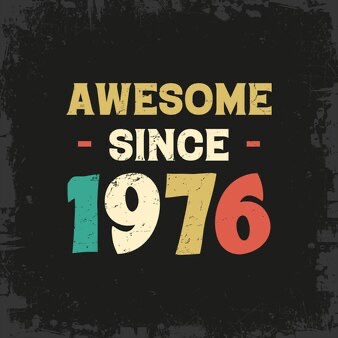In 1976, the world was immersed in a cultural tapestry woven with political intrigue, musical revolutions, and technological advancements. As the midpoint of the 1970s, this pivotal year left an indelible mark on history, shaping the trajectory of societies across the globe. #1976
1976

Politically, 1976 was a year of transition and tension. The United States was in the midst of its bicentennial celebrations, marking 200 years since the Declaration of Independence. Amid the patriotic fervor, the nation grappled with economic challenges and the aftermath of the Watergate scandal. Meanwhile, the Cold War persisted, with the U.S.S.R. firmly entrenched as a global superpower.
In 1976, the President of the United States was Gerald Ford. He assumed office on August 9, 1974, following the resignation of President Richard Nixon, and served until January 20, 1977. Gerald Ford was the 38th President of the United States and the only person to have served as both Vice President and President without being elected to either office.
In the Middle East, the geopolitical landscape was defined by the ongoing Arab-Israeli conflict. The year witnessed the hijacking of an Air France plane to Entebbe, Uganda, where Israeli commandos executed a daring rescue mission. This event showcased the complexity of international relations and the lengths to which nations would go to protect their citizens.
Musically, 1976 was a diverse and transformative year. The rock scene saw the emergence of punk rock, with the Ramones releasing their groundbreaking self-titled debut album. Simultaneously, artists like David Bowie continued to push boundaries with the release of “Station to Station,” showcasing the evolution of glam rock into new and experimental territories.
In 1976, the music scene was diverse, featuring a mix of rock, disco, and pop hits. Here are some popular songs from that year:
- “Don’t Go Breaking My Heart” – Elton John and Kiki Dee
- “Bohemian Rhapsody” – Queen
- “Dancing Queen” – ABBA
- “Play That Funky Music” – Wild Cherry
- “December, 1963 (Oh, What a Night)” – The Four Seasons
- “Blinded by the Light” – Manfred Mann’s Earth Band
- “Silly Love Songs” – Wings
- “More Than a Feeling” – Boston
- “You Should Be Dancing” – Bee Gees
- “Tonight’s the Night (Gonna Be Alright)” – Rod Stewart
These songs represent a snapshot of the musical landscape in 1976, showcasing the diversity of genres and styles that were popular during that time.
On the disco front, the genre reached its zenith with the release of the iconic “Saturday Night Fever” soundtrack in 1977. However, the groundwork for disco’s dominance was laid in 1976, with hits like ABBA’s “Dancing Queen” and Donna Summer’s “Love to Love You Baby” dominating the airwaves.
In the realm of technology, 1976 marked significant milestones. The Cray-1 supercomputer, a marvel of its time, was unveiled, showcasing the rapid evolution of computing power. Apple Inc. was founded by Steve Jobs, Steve Wozniak, and Ronald Wayne, laying the foundation for the tech giant we know today.
Popular culture was also captivated by the release of “Rocky,” a film that would go on to become a cultural phenomenon. Written by and starring Sylvester Stallone, the underdog story resonated with audiences and earned critical acclaim, winning three Academy Awards, including Best Picture.
In 1976, several films left an enduring impact on popular culture. Here are some notable movies from that year:
- Rocky: Directed by John G. Avildsen, this iconic sports drama starred Sylvester Stallone as Rocky Balboa, a small-time boxer who gets a shot at the world heavyweight championship.
- Taxi Driver: Directed by Martin Scorsese, this psychological thriller starred Robert De Niro as Travis Bickle, a mentally unstable Vietnam War veteran working as a taxi driver in New York City.
- Network: Directed by Sidney Lumet, this satirical film starred Peter Finch as Howard Beale, a news anchor who experiences a mental breakdown on air and becomes a populist sensation.
- All the President’s Men: Directed by Alan J. Pakula, this political thriller starred Robert Redford and Dustin Hoffman as journalists Bob Woodward and Carl Bernstein, uncovering the Watergate scandal.
- A Star Is Born: Directed by Frank Pierson, this musical drama starred Barbra Streisand and Kris Kristofferson, telling the story of a young singer’s rise to fame and the downfall of an established star.
- Carrie: Directed by Brian De Palma, this horror film based on Stephen King’s novel starred Sissy Spacek as Carrie White, a high school girl with telekinetic powers.
- King Kong: Directed by John Guillermin, this remake of the classic monster film featured Jeff Bridges and Jessica Lange in a modern retelling of the giant ape’s story.
These films reflect the diversity of genres and storytelling styles that captivated audiences in 1976, contributing to a memorable year in cinema.
In the sporting arena, 1976 was a year that etched its name in history, particularly in the realm of the Summer Olympics. The games were hosted in Montreal, Canada, and witnessed notable moments, including Nadia Comăneci’s perfect 10 in gymnastics—a feat that would become legendary. Comăneci, a Romanian gymnast, captivated the world with her flawless routines, earning her a total of seven perfect scores and three gold medals.
The political landscape of Africa was marked by significant events in 1976. The Soweto Uprising in South Africa, sparked by the government’s enforcement of teaching in Afrikaans, led to widespread protests and a brutal crackdown. The repercussions of this event reverberated globally, drawing attention to the oppressive apartheid regime and galvanizing international efforts against it.
On the literary front, the world bid farewell to two literary giants—Agatha Christie and Wallace Stegner—who passed away in 1976. Christie, the renowned queen of mystery, left behind a legacy of detective fiction that continues to captivate readers. Stegner, an influential American writer, contributed to the literary landscape with works like “Angle of Repose,” which won the Pulitzer Prize.
In the realm of science and space exploration, Viking 1 successfully landed on Mars, marking a historic achievement in the quest to understand the mysteries of our neighboring planet. The mission included the deployment of the first Mars rover, providing unprecedented insights into the Martian surface.
The world of fashion in 1976 was characterized by a blend of disco-inspired glamour and a nod to the casual chic of the ’70s. Bell-bottoms, platform shoes, and bold patterns dominated the fashion scene, reflecting the energetic and expressive spirit of the era. Designers embraced the eclectic and diverse influences of the time, giving rise to iconic looks that continue to influence fashion today.
1976 was also a year of technological innovation in the automotive industry. The first generation of Honda Accord was introduced, setting the stage for the success of this popular model in the years to come. Additionally, advancements in automotive safety led to the introduction of airbags in some high-end models, a crucial development that would become a standard feature in vehicles in subsequent decades.
In the world of technology, 1976 saw the advent of the inkjet printer, a groundbreaking innovation that would revolutionize printing technology. IBM introduced the IBM 3800, the first commercially successful printer to use this technology. This marked a significant step forward in the accessibility of high-quality printing for businesses and individuals alike.
The global economy faced challenges as oil prices surged due to geopolitical tensions in the Middle East. The oil crisis of 1973 continued to have far-reaching effects, leading to economic recessions in various parts of the world. Nations grappled with the need to diversify energy sources and reduce dependence on oil, setting the stage for future discussions on sustainable energy.
The average gas price in the U.S. in 1976 was around 59 cents per gallon. However, it’s important to note that prices could vary significantly by region, and there were periods of volatility during the decade.
Environmental awareness gained momentum in 1976 with the celebration of the first Earth Day. The event aimed to raise consciousness about environmental issues and promote sustainable practices. This marked a turning point in public awareness, laying the groundwork for future environmental movements and legislation aimed at protecting the planet.
In the realm of medicine, 1976 was notable for the identification of the Ebola virus. The first recorded outbreak occurred in Sudan and Zaire (now the Democratic Republic of the Congo). This discovery initiated ongoing efforts to understand and combat the deadly virus, highlighting the importance of global collaboration in addressing emerging health threats.
The gaming industry experienced a significant moment with the release of the arcade game “Breakout,” developed by Atari. Designed by a young Steve Jobs and Steve Wozniak, the game showcased the potential of video gaming as a form of entertainment. This laid the groundwork for the video game revolution that would unfold in the subsequent decades.
1976 was a year of political change in Argentina, as the military junta took control in a coup. This marked the beginning of a period of authoritarian rule, characterized by human rights abuses and political repression. The impact of this regime would reverberate for years, leaving a lasting imprint on the nation’s history.
Culturally, the year witnessed the birth of punk literature with the publication of Patti Smith’s “Just Kids.” The memoir delved into Smith’s relationship with artist Robert Mapplethorpe and offered a raw and honest portrayal of the New York City art scene in the late 1960s and 1970s. The book went on to win the National Book Award for Nonfiction in 2010.
In the world of television, 1976 saw the premiere of “Charlie’s Angels,” a groundbreaking show that featured a trio of female detectives. The series, created by Ivan Goff and Ben Roberts, became a cultural phenomenon, challenging traditional gender roles on television and inspiring a generation of viewers.
In 1976, popular TV shows spanned various genres, reflecting the diverse tastes of audiences. Here are some notable TV shows from that year:
- “Happy Days”
- “Charlie’s Angels”
- “MAS*H”
- “One Day at a Time”
- “Laverne & Shirley”
- “The Bionic Woman”
- “The Six Million Dollar Man”
- “All in the Family”
- “Three’s Company”
- “The Jeffersons”
These shows not only entertained viewers but also left a lasting impact on popular culture, contributing to the rich television landscape of the 1970s.
In 1976, various Christian movements and developments were underway, reflecting the diversity within the Christian faith. One notable event was the establishment of the Evangelical Lutheran Church in America (ELCA). Formed in 1976, the ELCA is one of the largest Christian denominations in the United States, representing a merger of three Lutheran church bodies.
Additionally, the Charismatic Movement continued to gain momentum within Christianity. This movement, characterized by a focus on spiritual gifts such as speaking in tongues and healing, transcended denominational boundaries. Many Christians, both within traditional churches and in independent charismatic fellowships, actively participated in this renewal movement.
On a global scale, the Catholic Church experienced the pontificate of Pope Paul VI, who served as Pope from 1963 until his death in 1978. During this time, Paul VI continued the implementation of the reforms initiated by the Second Vatican Council, addressing issues such as liturgical changes and social justice.
As the year drew to a close, the global community found itself on the cusp of a new era. The events of 1976 had set the stage for the social, political, and cultural shifts that would define the late 20th century. In retrospect, this pivotal year serves as a snapshot of a world in flux, navigating the complexities of a rapidly changing landscape.
Do you remember 1976?
If so feel free to share what you remember.
Check out Courageous Christian Father’s Wish list on Amazon where you can purchase and this items sent directly to him and they will be used for the ministry.
Subscribe To Courageous Christian Father!
Don’t miss any blog posts! Subscribe today! You can subscribe via WordPress or by entering your email! Thank you!
Follow Courageous Christian Father on WordPress.comFollow Courageous Christian Father on Social Media
Recent Posts:
Below are some examples of blog entries from all the blogs that I do. (Courageous Christian Father, Steve Sews Stuff, SteveZ DuckZ, and SteveZ DesignZ).
Thank You For Reading Courageous Christian Father!
Thank you for reading. Please feel free to share and like this blog post.
Clipart: Unsplash, Pixabay, Pexels, Openverse, Adobe Express, Adobe Stock, FreePik, MetroCreative, and more. This site uses Amazon Affiliate Ads & Google Ads.
About the Author
Discover more from Courageous Christian Father
Subscribe to get the latest posts sent to your email.


